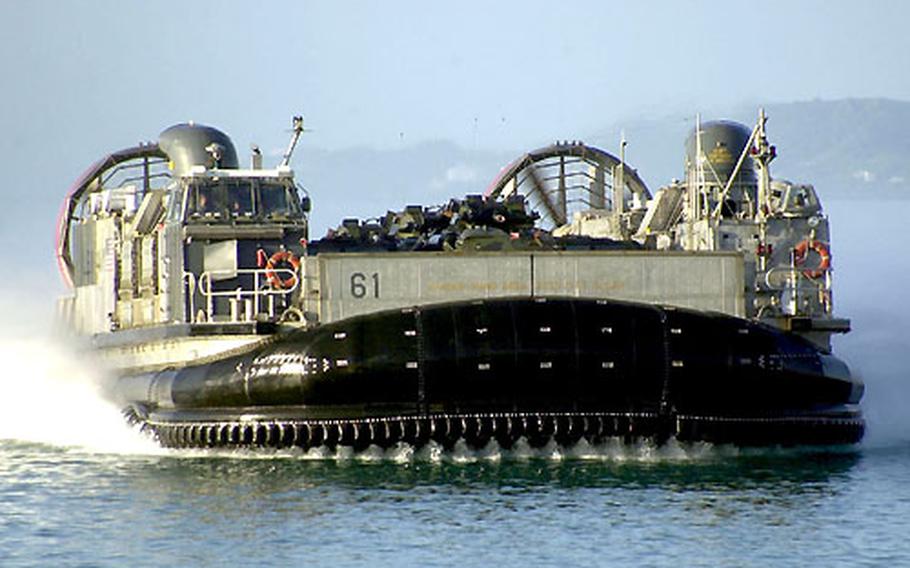
A landing craft, air cushioned — the giant hovercraft the Navy uses to move Marines and gear from ship to shore — closes in to Naval Facility White Beach, Okinawa. (Mark Oliva / S&S)
NAVAL FACILITY WHITE BEACH, Okinawa — Technically, as a gas turbine systems technician, Navy Chief Petty Officer Burt Moreau should be turning a wrench on an engine.
But out here, on the open Pacific Ocean, he’s part grease monkey, part salty sea sailor and part captain of his own craft.
As the lead man piloting a “landing craft, air cushioned” — commonly called LCAC and pronounced “el-cack” — he’s responsible for moving man and machine from ship to shore in an overgrown hovercraft. He’s the one who makes amphibious operations happen.
“You’ve got to be able to walk and chew gum at the same time with this thing,” Moreau said, explaining the maze of switches, dials and computer displays in the vessel’s cockpit. “You’ve got the valve thrusters, the pitch levers and the yoke and you’re working all three simultaneously.”
That’s just the driving part. Throw in navigation and parking the craft inside another ship or on just about any beach in the world.
Then there’s the maintenance. Moving parts tend to break. Salt water corrodes everything. Everything from military trucks to tanks has to be loaded in a specific order, not just for the way it will enter into battle but so the craft can ride over the sea’s pitches and swells. It’s nonstop work, evidenced by grease-stained flight suits and sweat-ringed T-shirts.
“You’ve got to be a tight group on these crafts,” Moreau said. “It’s definitely a learned trait to get down group coordination.”
Moreau relies on the rest of his crew for everything. Load masters whose job is to get Marines and their gear on and off quickly, double as extra sets of eyes, scanning for obstructions and hazards on the water. Mechanics who fix and maintain the LCAC’s four turbo-prop engines also help pilot the giant hovercraft. A quartermaster works on Moreau’s LCAC as a navigator.
Moreau is part of Assault Craft Unit 5, attached to the amphibious assault ship USS Essex. But unlike other sailors on a warship, his sailors don’t dress daily in Navy blue but in the green flight suits adorned with unit patches, including the one on Moreau’s sleeve that shows a fun meter pegged out. They don’t stand watches and their daily routines keep them working on the craft, away from the humdrum of shipboard life.
“Other people probably think we’re prima donnas,” Moreau said. “We hardly do anything but work on the craft.”
But that doesn’t mean his sailors are slacking.
“To be a crew member, you have to be a cut above the rest,” he said. “There’s a lot of responsibility. I rely heavily on my crew.”
Petty Officer 2nd Class Chris Moore has been in the Navy for eight years. “There’s always something new,” he said. “From operating the craft to embarking Marines and gear to the maintenance, we’re always getting into something that’s different than the last time.”
Moore’s job as the craft’s engineer is a “big responsibility,” one shipboard sailors usually leave to chief petty officers.
“We fix one thing,” Moore said, “and another problem comes up” — not surprising considering the craft uses 11 separate hydraulic systems and eight gear boxes.
“It’s a lot of machinery in a small area,” he said. “I’m still learning the ins and outs of this job. I don’t think I’ll ever get tired of it.”
Navy Petty Officer 2nd Class Robert Helmick is the craft’s load master. He’s a boatswain’s mate by trade but said life on the LCAC’s small deck beats the duties of bigger vessels.
“Most of the time, we’re doing everything together,” Helmick said. “No one says, ‘This isn’t my job.’ It’s all our jobs and we’re all pitching in to get things done.”
That teamwork produces a love affair with their craft. Moore said each LCAC has its own peculiar problems. He compared it to a shade tree mechanic’s obsession with working on a jalopy.
“I’ve had several different craft and I wanted to keep every single one of them,” Moreau added. “You get to where you like it, even if it has problems. It’s like being married, I guess. You’ve got the time invested in it and you just don’t throw that away.”
The same can be said of his crew, he added.
“It takes you a few hours to mesh together as a crew,” Moreau said, “but … by the time the end of a deployment comes around, you dread it because you don’t want to break up the crew.”